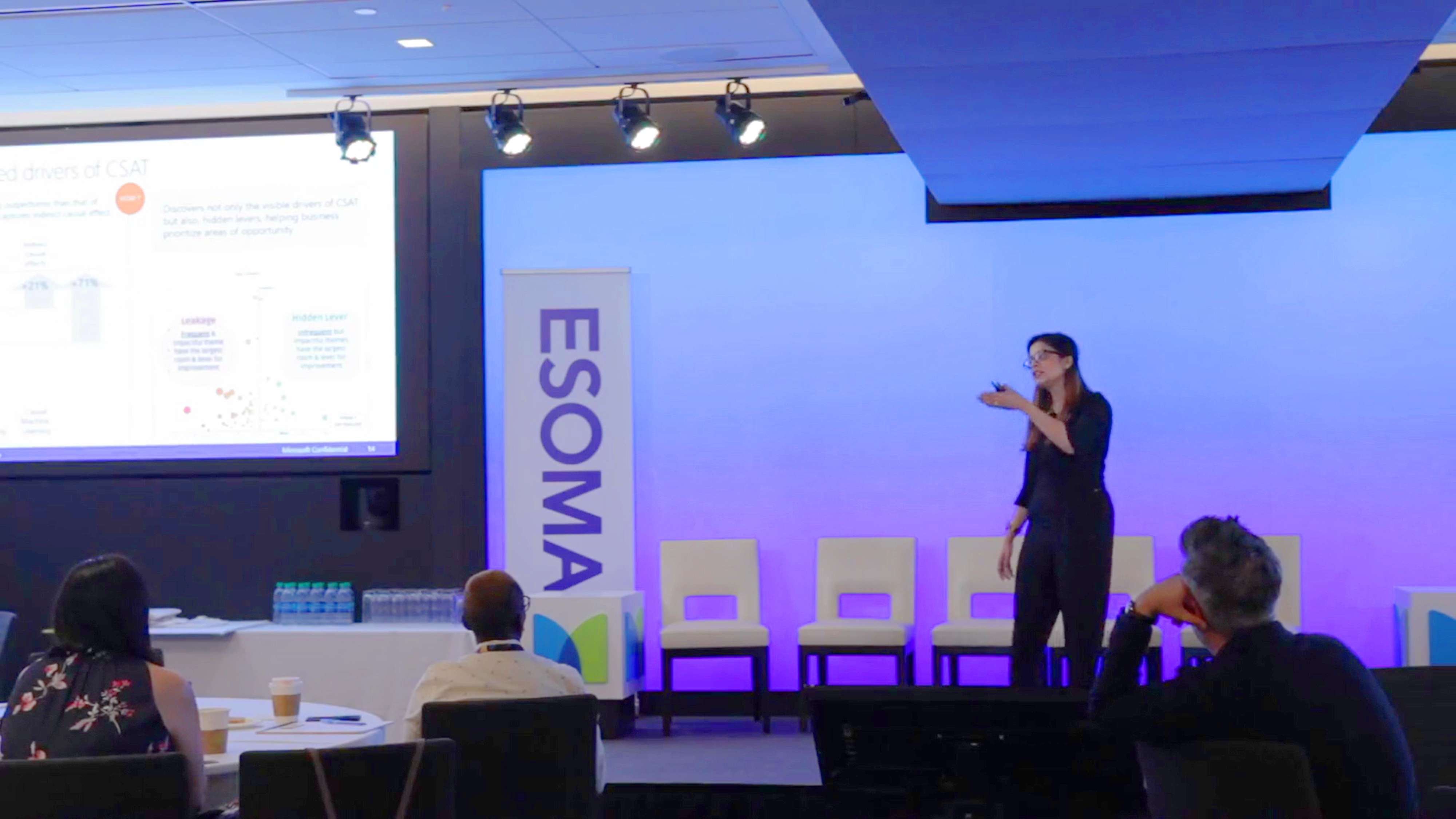Up Your Game with Analytics for Customer Experience:
6 Simple Steps for Finding and Executing on Your Key Drivers of Customer Experience
Understanding customer experience seems to be easy at first glance. Just ask your customers what they care about and then improve what’s bugging them. Oh boy. Life would be beautiful if it would be so straight forward. Before harvesting God wanted us to do analytics for customer experience 🙂
Do your customers have the opportunity to speak about what is on their mind? Or do you force them into the corset of your predesigned questionnaire? Do they? That’s great.
If you are advanced in your CX processes your are probably routing every single voice raised to the frontline.But do you also quantify all structurally raised opinions into well-defined specific and actionable theme categories? Awesome, even better.
Question: How you do this?
How you do the categorization with humans manually coding every of ten-thousands of verbatims? Lucky you that you got such a large budget. However, how do you know that they do it right? If you are satisfied with the quality, do you also like the time stretch it comes with?
Now, how do you use the information, right? Are the most frequently raise issues the top drivers of your CX? How do you know? Think twice.
Aah, you are using Key Driver Analysis as analytics for customer experience. You are even more advanced! However, have you ever thought about why its explanation power (R2) is so dammed low? There is a frightening reason you should know about.
CX Pros have gone thru most of those thought processes as we did. We spend the last two years pioneering a step-by-step approach together with lead clients like Microsoft, Sonos, or T-Mobile that describes well six simple stages to most effectively driving impact with customer feedback.
STEP 1: Customer Experience Means To Listen
That’s easy. Be sure to ask open-ended questions. Customers love this; it gives the most unbiased information and provides the possibility to collect much more feedback as questionnaires are very short. NPS earned its success for a reason.
However, feel free to adopt the rating question to your needs. Don’t care about benchmarking. With this process, you can free yourself from questionable industry benchmarking.
STEP 2: Listening at Scale … Requires AI
Most customer text feedback is not read or appropriately processed. This is an assault to customers. We owe this to our customers AND our shareholders. Those pioneers of you, that from early on experimented with text analytics an NLP software might be today disillusioned.
Indeed existing out of the box system do not provide very actionable categorizations. Even worse, we tested the predictive value of the output of such systems and found them to be vastly inferior to human coding.
So, no way around human coding? Besides the fact that most companies can’t effort the costs or the time needed to code all unstructured customer feedback fully, it turns out that even this can be entirely erroneous and inconsistent. While coders in scientific studies can code consistently about 80% of verbatims, real worlds coders often do not exceed 60%.
Luckily there is a today underleveraged breed of technology that we found to be able to outperform humans and conventional text analytics machines alike. It is underleveraged because it is this kind of deep learning AI that needs to be trained specific towards the domain, context, and question posed.
STEP 3 – Understanding The Unsaid, Understanding Hidden Motives … Requires AI
Unfortunately, the journey does not end in quantifying what customers are saying. The reason is simple. Some do point to issues that are just on top of their mind. What clients do not tell us is how significant the impact to its satisfaction and loyalty is when you fix the issue. They don’t tell you because of 1. You did not ask, and 2. They probably will not be able to seize it.
Key Driver Analysis (KDA) is needed as analytics for customer experience. However, it turns out that those techniques explain mostly far below 50% of the explained variance. Too low to be confident about its recommendations. There is an uncomfortable reason.
Those conventional statistical methods are about 100 years old (Recently read how Unilever leveraged them in 1919 to optimize Marketing). The drawbacks are several and summarized in three simple points:
Three drawback of conventional statistics (KDA)
- KDA assumes all themes, topic, and issues to have an independent impact on CX. However, an extremely friendly waitress that notoriously pores its hair into your soup will not win a CX award. Sometimes the best service cant makes immense when some fundamental factors are not met.
- KDA assumes the more, the better. We see, e.g., for the Sentiment score of a verbatim that its effects are highly nonlinear. In other words, the negative tone indicates much more (negative impact) that a positive tone.
- KDA assumes all themes to be on an equal level and does not influence each other. However, if someone mentions “Great service” and “friendly staff” that latter most probably driving the first, by not capturing these effects, results will be primarily screwed and hard to interpret.
So what’re the solutions? Yes, it’s AI. Machine learning can flexibly adapt to data without relying on unrealistic assumptions. Success Drivers pioneered in 2001 causal machine learning – we call it now Causal AI. It explains, on average, by factor 2, better why customers are loyal, and others don’t. Thats analytics for customer experience of the next generation.
STEP 4: Driving Impact … Requires Linkage to the Frontline
Typically analyst overemphasizes the important of insights. Sure it is important, but the ultimate goal is to drive effective actions.
Therefore the first and most important use of customer feedback is to route it back to the frontline. Nevertheless, it is often overlooked that the frontline needs guidance on how to interpret comments and to understand the priority and importance of raised topics.
This is where the results of the AI-powered Key Driver Analysis comes into play. Customer service personal will instinctively work on those topics that will be most often mentioned. They will try to be aware of the negative and try to maintain the positive.
Still what AI taught us, is that frequency and importance of raised topic are mostly unrelated. To be effective and interpret customer feedback correctly ALSO the frontline needs to know what’s important and which theme is instead mentioned as a top-of-mind association.
STEP 5: Driving Impact … Requires Linkage to the C-Suite
On top of that, many issues can’t be solved by the frontline. Sometimes it needs initiatives, infrastructure, training, investments. This is where the explanatory power of AI enfolds its full use. Now it is possible to plan actions and associated investments and simulate the actual impact on CX and resulting profits.
Let me ask you a question: Why is the finance department so powerful, much more powerful than CX? Does it bring in clients? Alternatively, does it invent new products? Maybe it does produce revenue? In fact, to every business, the finance team is a cost. Still, it has the CEO’s ear. Why? Because finance leaders create something incredibly powerful: TRANSPARENCY.
The lack of transparency in CX leadership is called – the Power Gap. If you create transparency, you have the power to move the organization.
Companies are catching up by making CX status across touchpoints, channels, segments, and business units transparent. However, why does close to every organization fails is to create transparency in what truly matters – in understanding what is the key lever to bring customer experience to the next level? AI can generate this transparency and thus to provide true power to CX leaders.
STEP 6: Gain Trust and Alignment … by Leveraging the Predictive Power of AI
The second gap when it comes to driving impact is the “Trust Gap”. When CFOs explain that cutting 10% costs, it’s entirely trustworthy that profits will – at least short-term- dramatically improve.
However, Marketing and Sales are handicapped. There is this “creepy unknown creature” called “customer,” which is less manageable as the internal processes. Even worse, other “magic forces” called “competition” is trying to attack us.
All this seems to be nebulous to many CEO’s. There is a Trust Gap. Marketer too often defends themselves with beautiful stories that too often proofed to not convert into reality.
What if you would have a tool that allows you to predict outcomes of actions? Sure, some would be skeptical. SONOS still dared to use it. They made predictions and implemented measures.
It turned out that predictions had been spot on. If predictions suddenly turn reality, prediction giver becomes “prophets”. If you can prove that your system has validity, you gain trust. Trust is truly needed to turn valuable insights into actions.
Are you ready to take actions? Then you should take a look at CX-AI.com!

